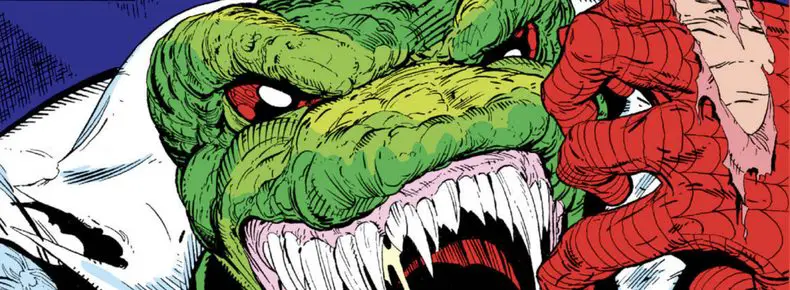The Amazing Spider-Man #313: “Slithereens!”
Curt Connors reverts to his Lizard form once again and threatens his family. Spider-Man, thankfully, happens to be in the area…
Lizards and demons and sharks, oh my!
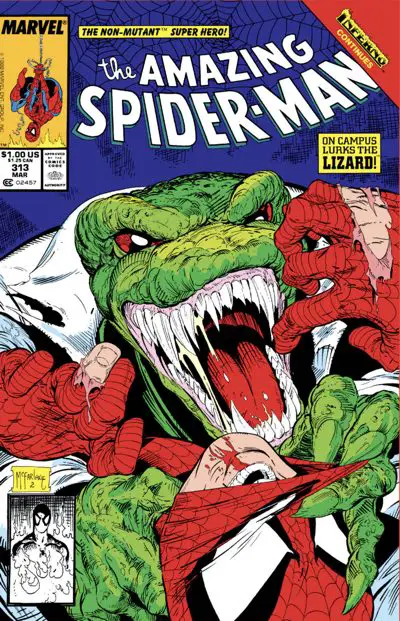
Artist: Todd McFarlane
Colors: Bob Sharen & John Wilcox
Letterer: Rick Parker
Publication Date: November 08, 1988
But, Wait, Inferno Gets Crazier!
The last two issues have been set during the time of the X-Men crossover event, Inferno. We’ve seen the lion statues in front of the New York Public Library come to life. Mary Jane’s jewelry transformed into a snake and attacked her.
And, now, in this issue, it’s Shark Week!
This is the issue where David Michelinie took the mandate to cross over with Inferno and turned in a script with as many crazy hijinks as he could think of.
The book starts with Mary Jane and Peter in a taxi in the Midtown Tunnel, where a shark attacks. Don’t worry, Peter can use his webshooters to stop the shark and punch him out.
See?
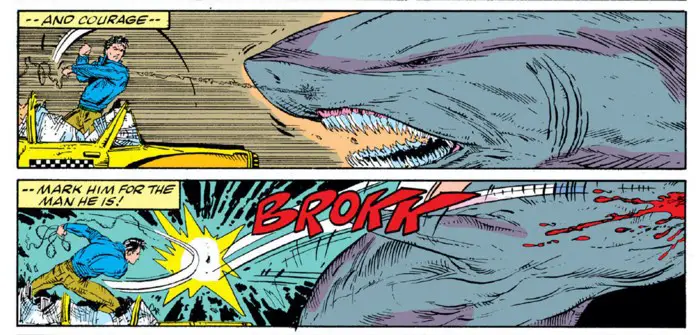
Then, the Spider-Man balloon from Macy’s Thanksgiving parade comes out of storage and takes on a life of its own. He strolls down the city streets. Spider-Man is forced to pop the balloon using a giant pin — the needle at the top of the Chrysler Building.
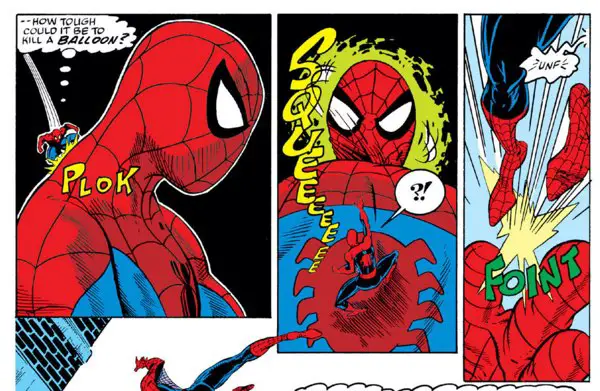
I like the way McFarlane simplified his style and drew the Spider-Man balloon in more of the classic Ditko style with fewer webs on the costume and smaller eyes.
I also can’t help but make comparisons to the Stay Puft Marshmallow Man, though this character’s destruction led to much less of a mess on the city streets.
This balloon was a bit of a current event at the time. It had just debuted in the Macy’s Thanksgiving Day Parade in 1987. Jim Shooter, whose term as Editor-in-Chief ended in April 1987, was called in to consult on the construction of the balloon, given his experiences in turning Marvel characters into real-world 3D forms. (Think of all the action figures coming out of Secret Wars.)
1987 was also the year of the legendary Marvel Universe float, which had a small New York City model around which cavorted the likes of Captain America, Wolverine, Hulk, Magneto, and Doctor Doom. Watch the video now and marvel (pun intended) at the way NBC gave the float a solid, uninterrupted two minutes of airtime.
Like I said, crazy hijinks, but played under the right umbrella to give them plausibility. It’s Inferno, man. Sit back and enjoy it. It was played seriously in the X-books, but here in a tie-in, things can go their own way.
The Lizard Slithers In
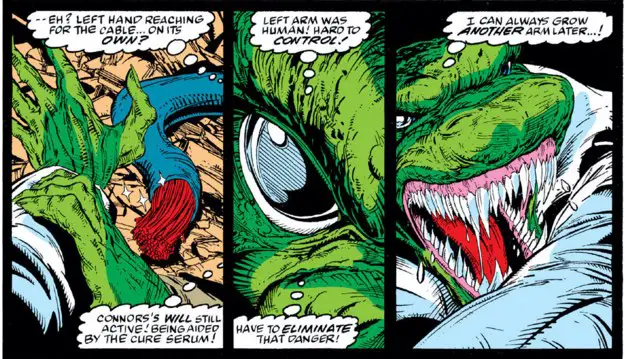
The main story of the issue is Curt Connors, who had thought he was gaining control of his changes into the Lizard before Inferno struck. His confidence is rattled, and Spider-Man must intervene to keep everyone alive long enough to realize what’s going on.
The Lizard is right up Todd McFarlane’s alley, as is this whole Inferno deal. He gets to draw a few demons in this issue, too, but it is The Lizard who is the big star. McFarlane’s interpretation of him is scary and animalistic. His textures and exaggerated physical features give him a new weight and horror. It’s no wonder that McFarlane would later use him in his opening storyline on the adjectiveless “Spider-Man” title.
In the end, Michelinie’s superhero story has another somewhat somber ending, as bad things happen to another of Peter Parker’s friends. First, it was the good doctor at ESU (who was reinstated a couple of issues later), and now it’s Curt Connors (Stan Lee couldn’t pass up a good alliteration), who by the end of the issue realizes he can’t return to his normal family life, just for their own safety.
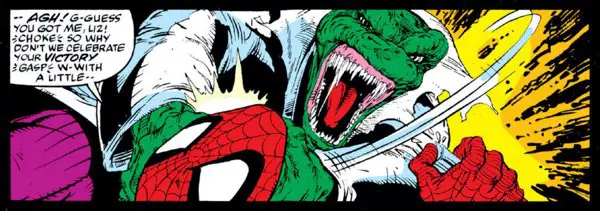
It’s classic Spider-Man, though, isn’t it? He does all the right things and still can’t be happy. Spider-Man can’t win, even when it seems like he does.
In the tease at the end, we see Jonathan Caesar preparing his legal exit from prison, promising a not terribly nice life for his one true love, Mary Jane. As I recall, this storyline doesn’t actually happen until after McFarlane’s departure from the title. It’s during Erik Larsen’s tenure that Caesar returns.
Now, for a long tangent away from the details of this issue and into a more general feeling I had in reading it:
I flipped through the last couple of issues before reading this one. I relived a feeling I had lost in comics a while back. There was that anticipation each month for the next issue of a series. Today, everything feels safer. There are more comics to choose from in a greater variety. You know that they’ll eventually be available in a collected edition. Heck, if the comic shop sells out of it, you still have the digital download option.
Those safety nets weren’t around 15 or 20 years ago. You picked up the issue when it came out, or you paid back issue bin prices weeks or months later, maybe at a local show or through a mail-order dealer or something.
It’s similar to what we have today, also, with television and movies. They don’t feel as special aymore because you can’t possibly miss them. If you “miss” a movie in the theater, it’ll be part of your monthly subscription to some streaming service for the rest of your life.
I remember buying “The Amazing Spider-Man” at the newsstand when McFarlane was on it in his last few months. I bought other comics, and even other Spider-Man comics, but I practically counted down the weeks until the next issue would show up at the stationery store I bought my comics at. I’d rip into it instantly. Every other comic would recede on the stands to a place I barely noticed until that one cool series could be read. Repeatedly. Maybe even copied with a pencil and paper. I drew a lot in those days.
These days, it’s silly to count down the weeks to the next issue of a comic. Schedules rarely work out that well. You can’t count on your favorite series always showing up on the racks the second Wednesday of the month.
When it came to a book like “Amazing Spider-Man,” you just never knew what you were going to get. Yes, you’d get Spider-Man web-slinging through the city and Peter and Mary Jane chatting, but everything else varied wildly from month to month. Look at the selection of villains we’ve seen in the last 16 issues already. Yes, some are forgettable, but there’s a good variety of them. There’s new and classic, cool and not-so-exciting, and those McFarlane breathed new life into with his art style.
You just never knew what the next issue would be. These days, comics careen from event to event so fast that series don’t get the chance to establish their own rhythms and find their place in the world. Everything has to be a major twist or it doesn’t feel “important.” I’m an old man who misses the monthly series of smaller stories that ramble from one plot to the next. I’m enjoying that as I read this Omnibus. In comparison to today’s comics, it feels like anarchy.
That doesn’t mean it doesn’t have its drawbacks. I’m aware of those. But I’m enjoying the different feeling these comics give me today with a bit of new self-awareness brought about by experience.
And, just for a little while in reading this issue, it was fun to have that feeling again.
Horizontal Storytelling
There’s a moment during the Spider-Man/Lizard fight that jumped out at me for being sub-optimal storytelling. Spider-Man’s swings in from the side and kicks Lizard over. It happens at the top of a page after a page turn. It’s meant to be a sudden surprise appearance.
This is the panel McFarlane drew for the moment:
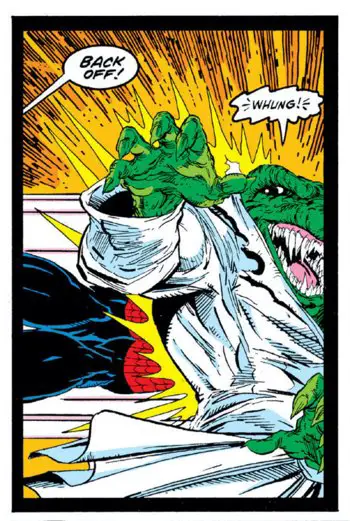
It’s an awkward composition. The Lizard is cut-off mid-snout. All you see of Spider-Man are his knees, really. The speed lines aren’t even there to indicate directionality. They’re there to emphasize the impact of Spider-Man’s feet on Lizard’s back.
The best part of this panel is the Lizard’s raised hand that adds a bit of dimension to the panel, which would otherwise be at a flat distance.
Now, here’s a moment (spoiler, on the off chance you care at this point) at the end of the fight scene that works extremely well with McFarlane’s horizontal layout:
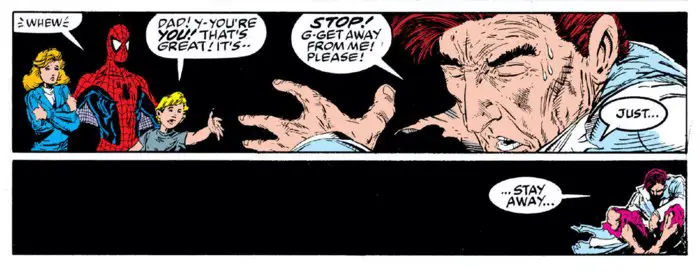
The first panel sets up the relationships between the characters very well. Spider-Man’s and Curt Connors’ family are on one side while Connors is on the far opposite side. It’s an an easy composition to read across with the word balloons. It also works with Spider-Man at a greater distance from the reader and Connors being closer, but turning away, his hand and his son’s outreached hand almost touching, but really very far apart.
But that second panel sells the moment beautifully. It’s Curt Connors in that devesatating moment when he realizes he’s a danger to the people he loves and needs to be isolated and left alone. He’s cramped into the corner, trying to get as far away from his family for their own safety, while it feels like the weight of the world is squeezing in on him. McFarlane pushes him up against the far panel corner, completely isolated and almost leaning against the panel borders.
It’s a very effective use of the panel shape.
Rembrandt Lighting
The painter Rembrandt had a favorite style of lighting he used in his paintings. He’s so well known for it that the term “Rembrandt Lighting” is used to this day.
It’s particularly popular in portrait photography circles. It involves angling a light at about 45 degrees so that half the face is lit up, and the shadow of the nose closes a loop of light on the opposite cheek just under the eye.
Here’s an example of it:

You can see how the right side of her face is fully lit and the opposite cheek has that trademark triangle of light.
Rembrandt used it in his own self-portrait:

Now that you know what it is, you’ll see it everywhere.
I spotted five instances where McFarlane used it in this issue, so I gathered them all up:
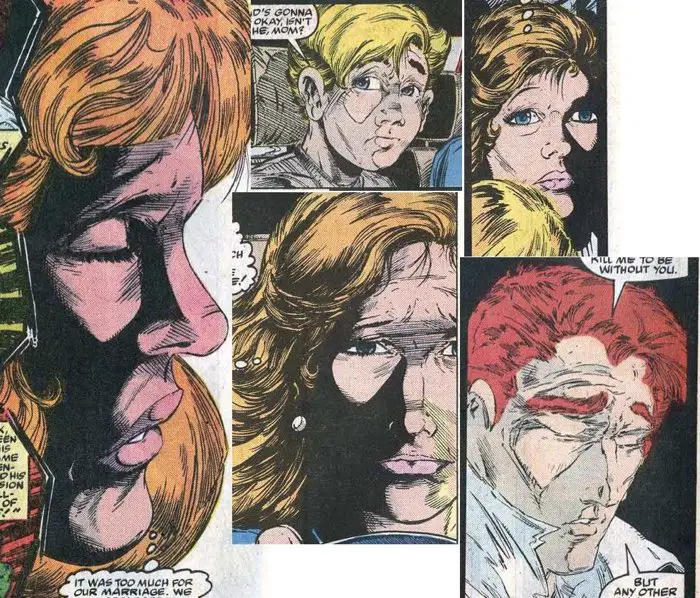
If you look back at the last 15 issues, I’m sure you’ll find more examples in just about every issue.
Hidden Spiders
As per McFarlane’s signature scroll, there are two hidden spiders in this issue’s cover.
The first is on Lizard’s shoulder, just above Spider-Man’s left hand.
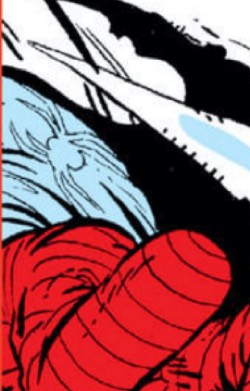
The second is on Lizard’s left hand, almost looking like a tattoo along his finger.
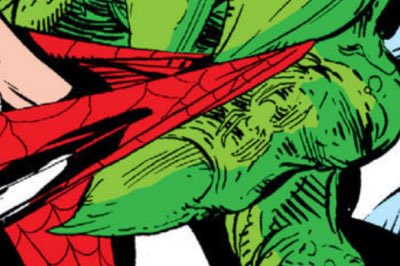
This cover also feels like a prelude to McFarlane’s first adjectiveless “Spider-Man” storyline. The Lizard featured in that one, also, but Spider-Man also had lots of rips in his costume.
Felix Watch
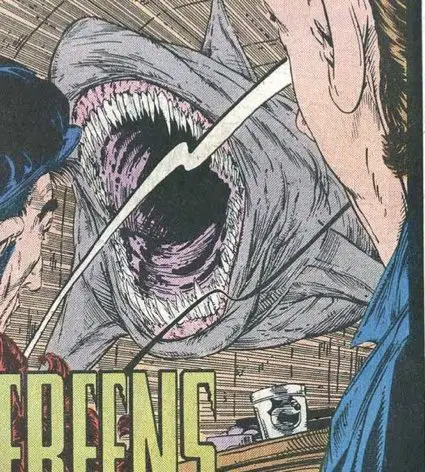
He’s right there on the dashboard of the taxi driver’s cab. Pay no attention to the shark just outside the window.
Next Issue: HO-HO-HO GET OUT!
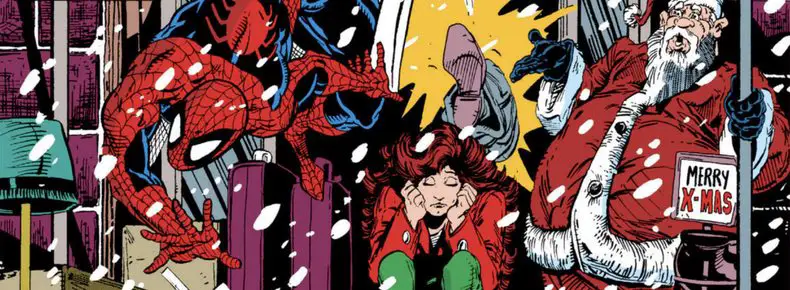
It’s Christmas time! And since this is a Spider-Man comic, you know what that means! Misery!
Mary Jane and Peter get evicted! No villains! Todd McFarlane has a whole issue of “civilians” to draw! How will it go?

